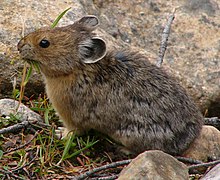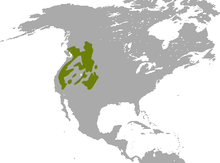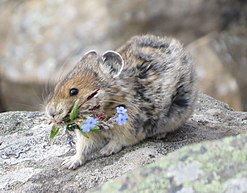American pika
| American pika[1] | |
|---|---|

| |
| An American pika feeding on grass in theCanadian Rocky Mountains | |
| Scientific classification | |
| Domain: | Eukaryota |
| Kingdom: | Animalia |
| Phylum: | Chordata |
| Class: | Mammalia |
| Order: | Lagomorpha |
| Family: | Ochotonidae |
| Genus: | Ochotona |
| Species: | O. princeps
|
| Binomial name | |
| Ochotona princeps (Richardson,1828)
| |
| Subspecies[5] | |
|
O. p. princeps | |

| |
| American pika range | |

TheAmerican pika(Ochotona princeps), adiurnalspecies ofpika,is found in the mountains of westernNorth America,usually in boulder fields at or above thetree line.They are herbivorous, smaller relatives ofrabbitsandhares.[6]Pikas have two different ways of foraging; they either directly consume food or they cache food in piles for the winter (haying).
Pikas are vocal, using both calls and songs to warn when predators are nearby and during thebreeding season.Predators of the pika includeeagles,hawks,coyotes,bobcats,foxes,andweasels.
Recent studies suggest populations in thesouthwestern United Statesare declining due to habitat loss andglobal warming.[7]However, the American pika is overall considered a species ofLeast Concern,and is still common in the northwestern United States and Canada.
Description
[edit]American pikas, known in the 19th century as "little Chief hares",[8]have a small, round, ovate body. Their body lengths range from 16.2 to 21.6 cm (6.4 to 8.5 in). Their hind feet range from 2.5 to 3.5 cm (1.0 to 1.4 in).[9]They usually weigh about 170 g (6.0 oz).[10]Body size can vary among populations. In populations withsexual dimorphism,males are slightly larger than females.[11]
The American pika is intermediate in size among pikas. The hind legs of the pika do not seem to be much longer than its front legs and its hind feet are relatively short when compared to most other lagomorphs.[11]It has densely furred soles on its feet except for black pads at the ends of the toes.[11]The ears are moderately large and suborbicular, and are hairy on both surfaces, normally dark with white margins. The pika's "buried" tail is longer relative to body size compared to other lagomorphs.[11]It has a slightly rounded skull with a broad and flat preorbital region. The fur color of the pika is the same for both sexes, but varies by subspecies and season.[11]The dorsal fur of the pika ranges from grayish to cinnamon-brown, often colored with tawny or ochraceous hues, during the summer. During winter, the fur becomes grayer and longer.[11]The dense underfur is usually slate gray- or lead-colored. It also has whitish ventral fur. Males are called bucks and females are called does like rabbits.

Distribution and habitat
[edit]The American pika can be found throughout the mountains of western North America, from centralBritish ColumbiaandAlbertainCanadato theUSstates ofOregon,Washington,Idaho,Montana,Wyoming,Colorado,Utah,Nevada,California,andNew Mexico.[10]Of the 30 existing species of pika, it is one of only two which inhabit North America, along with thecollared pika(O. collaris). In relation to the distribution of the American pika, the collared pika is located farther north and is separated by a gap of about 800 km (500 mi) extending across British Columbia and Alberta.[12]
Pikas inhabit talus fields that are fringed by suitable vegetation in alpine areas. They also live in piles of broken rock.[11][13]Sometimes, they live in man-made substrate such as mine tailings and piles of scrap lumber. Pikas usually have their den and nest sites below rock, around 20–100 cm (8–39 in) in diameter, but often sit on larger and more prominent rocks. They generally reside inscreenear or above thetree line.Pikas are restricted to cool, moist microhabitats on high peaks or watercourses.[13]Intolerant of high diurnal temperatures, in the northern portion of their range, they may be found near sea level, but in the south they are rare below 2,500 m (8,200 ft).[11]American pikas rely on existing spaces in the talus for homes and do not dig burrows. However, they can enlarge their homes by digging.[11]
Diet
[edit]The American pika is a generalistherbivore.It eats a large variety of green plants, including different kinds ofgrasses,sedges,thistles,andfireweed.Although a pika can meet its water demand from the vegetation eaten, it does drink water if it is available in its environment.[14]
Pikas have two different ways of foraging; they directly consume food (feeding) or they cache food in haypiles to use for a food source in the winter (haying).[11]They feed throughout the year while haying is limited to the summer. Since they do not hibernate, pikas have greater energy demands than other montane mammals. They also make 13 trips per hour to collect vegetation when haying, up to a little over 100 trips per day.[15]The timing of haying seems to correlate to the amount of precipitation from the previous winter.[16]Pikas start and then quit haying earlier in years following little snow and an early spring. In areas at lower elevations, haying begins before the snow has melted at high altitudes; at higher elevations, haying continues after it ends in lower elevations.[16]
When haying, pikas harvest plants in a deliberate sequence, corresponding to their seasonal phenology.[11]They seem to assess the nutritional value of available food and harvest accordingly. Pikas select plants that have the higher caloric, protein, lipid, and water content.[11]Forbs and tall grass tend to be hayed more than eaten directly. Haypiles tend to be stored under the talus near the talus-meadow interface, although they may be constructed on the talus surface. Males generally store more vegetation than females and adults usually store more than juveniles.[11]Like alllagomorphs(rabbits, hares, pikas), the American pika creates, expels & eatscecotropes(cecotrophy) to get more nutrition from its food. Cecotropes have more energy value than stored plant food and the American pika may consume them directly or store them for later.[11]
Life history
[edit]
The American pika isdiurnal.The total area of land that a pika uses is known as a home range. About 55% of its home range is territory that the pika defends against intruders. Territory size can vary from 410 to 709 m2(4,410 to 7,630 sq ft) and is dependent on configuration, distance to vegetation, and quality of vegetation.[11]The home ranges of pikas may overlap, with the distances of the home ranges of a mated pair being shorter than that of the nearest neighbors of the same sex.[11]Spatial distances between adults of a pair is greatest during early and midsummer and reduces during late summer and early autumn. Pikas defend their territories with aggression. Actual aggressive encounters are rare and usually occur between members of the same sex and those unfamiliar with each other. A pika may intrude on another's territory, but usually when the resident is not active. During haying, territorial behavior increases.[14]
Adult pikas of the opposite sex with territories adjacent form mated pairs. When more than one male is available, females exhibitmate choice.[11]Pikas are reflex ovulators; ovulation only occurs after copulation, and they are also seasonally polyestrous. A female has two litters per year and these litters average three young each. Breeding takes place one month before the snow melts and gestation lasts around 30 days. Parturition occurs as early as March in lower elevations, but occurs from April to June at higher elevations. Lactation significantly reduces a female's fat reserves and they only wean the second litter if the first does not survive, despite exhibiting postpartum estrus.[11]Pikas are bornaltricial,being blind, slightly haired, and having fully erupted teeth. They weigh between 10 and 12 g (0.35 and 0.42 oz) at birth. At around nine days old, they are able to open their eyes.[11]Mothers forage most of the day and return to the nest once every two hours to nurse the young. Young become independent after four weeks, around the same time they are weaned.[11]Young may remain in their natal or an adjoining home range. When in their home range, young occupy areas away from their relatives as much as possible. Dispersal appears to be caused by competition for territories.[17]
Pikas are vocal, using both calls and songs to communicate among themselves. A call is used to warn when a predator is lurking nearby, and a song is used during thebreeding season(males only), and during autumn (both males and females).[10]Predators of the pika includeeagles,hawks,coyotes,bobcats,mountain lions,foxes,andweasels.
Taxonomy
[edit]The American pika was described in the scientific literature byJohn RichardsoninFauna Boreali-Americanain 1828. The original scientific name wasLepus (Lagomys) princeps.[18]

Conservation and decline
[edit]As they live in the high and cooler mountain regions, they are very sensitive to high temperatures, and are considered to be one of the best early warning systems for detecting global warming in the western United States.[19]Temperature increases are suspected to be one cause of American pikas moving higher in elevation[20]in an attempt to find suitable habitat, as well as cooler temperatures. American pikas, however, cannot easily migrate in response to climate change, as their habitat is currently restricted to small, disconnected habitat "islands" in numerous mountain ranges.[21]Pikas can die in six hours when exposed to temperatures above 25.5 °C (77.9 °F) if individuals cannot find refuge from heat. In warmer environments, such as during midday sun and at lower elevation limits, pikas typically become inactive and withdraw into coolertalusopenings.[16]Because of behavioral adaptation, American pikas also persist in the hot climates ofCraters of the MoonandLava BedsNational Monuments (Idaho and California, respectively). Average and extreme maximum surface temperatures in August at these sites are 32 and 38 °C (90 and 100 °F), respectively.[22]
Recent studies suggest some populations are declining due to various factors, most notably global warming.[20]A 2003 study, published in theJournal of Mammalogy,showed nine of 25 sampled populations of American pika had beenextirpatedin theGreat Basin,leading biologists to conduct further investigations to determine if the species as a whole is vulnerable.[23]
In 2010, the US government considered, then decided not to add the American pika under the US Endangered Species Act.[24]In theIUCN Red List,it is still considered a species of Least Concern.[3]
The Pikas in Peril Project,[25]funded through theNational Park ServiceClimate Change Response Program, began data collection in May 2010. A large team of academic researchers and National Park Service staff - from three universities and eight national parks - worked together to address questions regarding the vulnerability of the American pika to futureclimate change scenariosprojected for the western United States. The project concluded in 2016.[26]
More recent studies have found widespread extirpations and range retractions at lower elevations which are typically warmer and drier, patterns that have been further attributed to varying aspects of climate change such as warmer summer and winter temperatures and changes in precipitation.[27][28][29][30]For example, one study found upslope retractions in 44 of 64 watersheds surveyed in theNorthern Rockies,with retractions averaging 281 m (922 ft).[31]Another study inNorth Cascades National ParkinWashingtonfound that a single winter of little to no snow caused drastic declines in pika abundance, highlighting how snowpack provides a necessary insulation against cold winter temperatures.[32]
References
[edit]- ^Hoffman, R.S.; Smith, A.T. (2005)."Order Lagomorpha".InWilson, D.E.;Reeder, D.M (eds.).Mammal Species of the World: A Taxonomic and Geographic Reference(3rd ed.). Johns Hopkins University Press. pp. 191–192.ISBN978-0-8018-8221-0.OCLC62265494.
- ^Jopling, A.V (1981)."Stratigraphic, Sedimentological and Faunal Evidence for the Occurrence of Pre-Sangamonian Artefacts in Northern Yukon".Arctic.34(1).doi:10.14430/arctic2499.
- ^abSmith, A.T.; Beever, E. (2016)."Ochotona princeps".IUCN Red List of Threatened Species.2016:e.T41267A45184315.doi:10.2305/IUCN.UK.2016-3.RLTS.T41267A45184315.en.Retrieved12 November2021.
- ^"NatureServe Explorer 2.0".explorer.natureserve.org.Retrieved4 November2022.
- ^Hafner, David J.; Smith, Andrew T. (April 2010)."Revision of the subspecies of the American pika,Ochotona princeps(Lagomorpha: Ochotonidae) ".Journal of Mammalogy.91(2): 401–417.doi:10.1644/09-MAMM-A-277.1.
- ^"Pikas".World Wildlife Fund.Archivedfrom the original on 9 May 2007.Retrieved2007-05-15.
- ^"Pikas Disappearing from Parts of the West Due to Climate Change | U.S. Geological Survey".usgs.gov.Retrieved2023-04-15.
- ^Mearns, B & R.John Kirk Townsend: Collector of Audubon's Western Birds and Mammals(PDF).p. 108.Retrieved2009-10-06.
- ^"Ochotona princeps".public.srce.hr.Archived fromthe originalon 2005-03-18.Retrieved2007-05-15.
- ^abc"American Pika".NatureWorks.Archivedfrom the original on 1 May 2007.Retrieved2007-05-15.
- ^abcdefghijklmnopqrstSmith, Andrew T.; Weston, Marla L. (1990-04-26)."Ochotona princeps"(PDF).Mammalian Species(352). The American Society of Mammalogists: 1–8.doi:10.2307/3504319.JSTOR3504319.Retrieved2009-10-02.
- ^MacDonald, Stephen O.; Jones, Clyde (1987)."Ochotona collaris".Mammalian Species(281): 1–4.doi:10.2307/3503971.JSTOR3503971.
- ^abHafner, D.J. (1993). "North American pika (Ochotona princeps) as a late Quaternary biogeographic indicator species ".Quaternary Research.39(3): 373–380.Bibcode:1993QuRes..39..373H.doi:10.1006/qres.1993.1044.S2CID83513667.
- ^abMartin, J. W. 1982. Southern pika (Ochotona princeps) biology and ecology: a literature review.
- ^Erik A. Beever; Peter F. Brussard & Joel Berger (January 2003)."Patterns of apparent extirpation among isolated populations of pikas (Ochotona princeps) in the Great Basin ".Journal of Mammalogy.84(1): 37–54.doi:10.1644/1545-1542(2003)084<0037:POAEAI>2.0.CO;2.
- ^abcSmith, A.T. (November 1974). "The distribution and dispersal of pikas: influences of behavior and climate".Ecology.55(6): 1368–1376.Bibcode:1974Ecol...55.1368S.doi:10.2307/1935464.JSTOR1935464.
- ^Peacock, MM (1997)."Determining natal dispersal patterns in a population of North American pikas (Ochotona princeps) using direct mark-resight and indirect genetic methods ".Behavioral Ecology.8(3): 340–350.doi:10.1093/beheco/8.3.340.
- ^Richardson, John (1829).Fauna boreali-americana.London: J. Murray.Retrieved20 December2014.
- ^Brown, Paul (August 21, 2003)."American pika doomed as 'first mammal victim of climate change'".The Guardian.London.Retrieved2007-05-15.
- ^abBlakemore, Bill (May 9, 2007)."Route to Extinction Goes up Mountains, Scientists Say".World News with Charles Gibson.Retrieved2007-05-15.
- ^"Species | Protecting Wildlife".
- ^Dept. of Interior, Fish and Wildlife Service,12-month Finding on a Petition to List the American Pika as Threatened or Endangered
- ^van Noordennen, Pieter (May 9, 2007)."American Pika".GORP.Archived fromthe originalon May 13, 2010.RetrievedMay 15,2007.
- ^Reis, Patrick (2010-02-05)."Obama Admin Denies Endangered Species Listing for American Pika".The New York Times.Archivedfrom the original on 9 February 2010.Retrieved2010-02-07.
- ^"Pika Monitoring in the Upper Columbia Network".Archived fromthe originalon 2017-01-25.Retrieved2014-03-27.
- ^Thomas J Rodhouse; et al."Pikas in Peril".ResearchGate.
- ^Billman, Peter D.; Beever, Erik A.; McWethy, David B.; Thurman, Lindsey L.; Wilson, Kenneth C. (2021)."Factors influencing distributional shifts and abundance at the range core of a climate-sensitive mammal".Global Change Biology.27(19): 4498–4515.doi:10.1111/gcb.15793.ISSN1365-2486.PMID34236759.S2CID235767277.
- ^Stewart, Joseph A. E.; Wright, David H.; Heckman, Katherine A. (2017-08-30)."Apparent climate-mediated loss and fragmentation of core habitat of the American pika in the Northern Sierra Nevada, California, USA".PLOS ONE.12(8): e0181834.Bibcode:2017PLoSO..1281834S.doi:10.1371/journal.pone.0181834.ISSN1932-6203.PMC5576638.PMID28854268.
- ^Stewart, Joseph A. E.; Perrine, John D.; Nichols, Lyle B.; Thorne, James H.; Millar, Constance I.; Goehring, Kenneth E.; Massing, Cody P.; Wright, David H. (May 2015). Riddle, Brett (ed.)."Revisiting the past to foretell the future: summer temperature and habitat area predict pika extirpations in California".Journal of Biogeography.42(5): 880–890.Bibcode:2015JBiog..42..880S.doi:10.1111/jbi.12466.S2CID84793755.
- ^Beever, Erik A.; Ray, Chris; Wilkening, Jenifer L.; Brussard, Peter F.; Mote, Philip W. (2011)."Contemporary climate change alters the pace and drivers of extinction".Global Change Biology.17(6): 2054–2070.Bibcode:2011GCBio..17.2054B.doi:10.1111/j.1365-2486.2010.02389.x.ISSN1365-2486.S2CID86079175.
- ^Billman, Peter D.; Beever, Erik A.; McWethy, David B.; Thurman, Lindsey L.; Wilson, Kenneth C. (October 2021)."Factors influencing distributional shifts and abundance at the range core of a climate‐sensitive mammal".Global Change Biology.27(19): 4498–4515.doi:10.1111/gcb.15793.ISSN1354-1013.PMID34236759.S2CID235767277.
- ^Johnston, Aaron N.; Christophersen, Roger G.; Beever, Erik A.; Ransom, Jason I. (2021)."Freezing in a warming climate: Marked declines of a subnivean hibernator after a snow drought".Ecology and Evolution.11(3): 1264–1279.Bibcode:2021EcoEv..11.1264J.doi:10.1002/ece3.7126.ISSN2045-7758.PMC7863385.PMID33598129.
External links
[edit]- View thePika genomeinEnsembl.
- View theochPri3genome assembly in theUCSC Genome Browser.
- American pika federal petition


